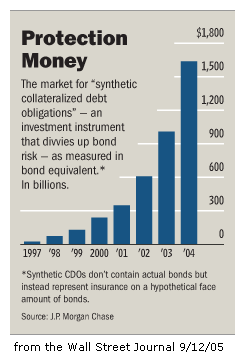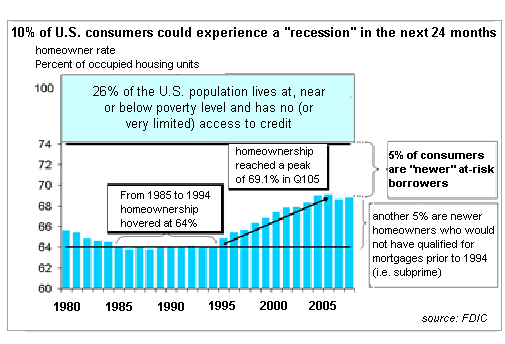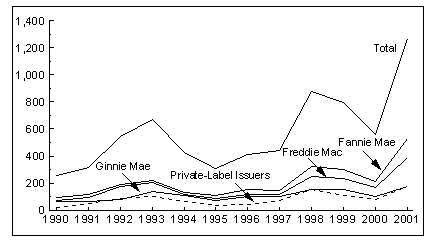

|
| weblog/wEssays archives | home | |
|
Derivatives and the Real Estate Bubble (November 8, 2006)  Reader Kenny G. posed a fascinating question about the impact of derivatives on
the housing bubble:
Reader Kenny G. posed a fascinating question about the impact of derivatives on
the housing bubble:
"My question is this: How will the huge amount of credit derivatives play out in way of the deflating of the bubble? I hate to say it but, "this time MAY be different"? I have read that there was about $1 trillion worth as little as 5 years ago and now there is in excess of $27 trillion. Will the need to put this "money" somewhere give this market a true early floor or will there be some unwinding that will create an even worst result?Though no expert, I'll do my best. There are at least three parts to the answer: the impact of mortgage-backed securities derivatives, the growth of derivatives across all financial markets, and the demand for a "home" for excess capital. The scale of derivatives appears to be fully 10 times greater than $27 trillion; according to The Economist: "Finance has been convulsed by a computer-enhanced frenzy of creativity. In today's caffeine-fuelled dealing rooms, a barely regulated private equity group could very well borrow money from syndicates of private lenders, including hedge funds, to spend on taking public companies private. At each step, risks can be converted into securities [like mortgage-backed securities], sliced up...re-packaged, sold on and sliced up again. The endless opportunities to write contracts on underlying debt instruments explains why the outstanding value of credit-derivatives contracts has rocketed to $265 trillion – $9 trillion more than six months ago, and seven times as much as in 2003."Derivatives have also skyrocketed in value in the past 5 years as the need to take on more risk has increased. The demand for superior return in a low-interest environment has driven the capital markets into accepting more and more risk in an attempt to "beat the market" or do better than a safe 6-month Treasury note. (Recall that "risk and return" are related; the lower the risk, the lower the return, and vice versa.) To offset the greater risks, money managers have turned to derivatives for portfolio insurance. 
Here's (basically) how a derivative works. (Skip this if you already know.) The simplest way to grasp a derivative is to consider put and call options on a stock or index. Let's say you invest a whopping chunk of money in XYZ Corporation which trades at $50 a share. To protect yourself against a sudden collapse in the value of XYZ shares, you buy put options, which increase in value as XYZ drops. If you own 10,000 shares of XZY, that means you've got $500,000 invested. If you buy contracts for 10,000 shares (options come in contracts of 100, so this means you'd buy 100 contracts) for, say $1 a share, then you'd spend $10,000 to protect your investment against a massive drop. Say your put was at a strike price of $50; if XYZ plummeted to $40, your put options would be worth $9, or the difference between the strike price and the current price. Even though your shares have lost $10 in value, your put gained $10 in value. So you've suffered no loss despite the steep drop in XYZ's value. If XYZ stays at $50 or goes up, your option expires worthless, which means the party which wrote the option pockets the $10,000 and you receive nothing--very much an insurance policy. But your worst case scenario was effectively reduced to the cost of the puts: you couldn't lose more than $10,000, even if XYZ stayed at $50/share. Now this may sound confusing, but the reason why no one worries too much about puts and calls unraveling is to write such an option, you need to own or at least control the underlying security. In other words, there is collateral for the "insurance" being sold. Not so with all derivatives. In more exotic derivatives, the potential loss to the firm issuing the derivative is covered by another derivative. Thus, derivatives are swapped, layered, chained and intertwined so that every potential loss is covered by another derivative. If everything stays stable, then the firm writing the derivative pockets the fee and pays out nothing. Issuing derivatives is highly profitable, and seemingly safe. Major investment houses may juggle several hundred derivatives contracts at any one time, thereby balancing all the (visible) risks of their portfolios. So what can go wrong? Somewhere down the chain, if someone didn't adequately cover their risk, some shock in the financial system may cause a loss they can't cover. They go belly up, and as a result the firms expecting these guys will pay off their derivative bets find their "insurance" just became worthless. They in turn may find themselves short of cash to cover derivatives they wrote, and then they have to sell hard assets such as stocks and bonds to cover the losses. Such selling may well trigger additional selling, which will trigger more derivatives claims, which launches yet more selling... and that's how the entire "safe" structure could collapse in giant waves of selling. Here's how derivatives impact the housing bubble. Small-town bankers still write mortgages and keep the "paper," meaning they actually own the mortgage and collect the principal and interest payments from the homeowner. But most of the hundreds of billions of sub-prime and option-ARM mortgages written in the past few years have been aggregated into vast pools of mortgages which are then sold much like bonds. These mortgage-backed securities (MBS) are often tranched (sliced and diced) into various levels of risk. The buyers then offset the risk by purchasing derivatives which will increase if the underlying mortgages go south (i.e. become non-performing loans as the homeowner defaults and stops paying the mortgage). Here's a chart showing the recent rapid rise in MBS:  To connect the dots, scroll back up and look at the chart which shows that 10% of U.S.
households are in danger of defaulting on their debt: (the chart is from the FDIC;
in other words, this is a Federal agency's assessment of the risks.)
To connect the dots, scroll back up and look at the chart which shows that 10% of U.S.
households are in danger of defaulting on their debt: (the chart is from the FDIC;
in other words, this is a Federal agency's assessment of the risks.)
Let's say "only" 5% of homeowners default--that's some 4 million mortgages. Those mortgages are spread out in MBS all over the planet, and as millions of people stop paying their principal and interest (each one goes to a different tranch, by the way), then the owners of those MBS start collecting less income. The value of their mortgage security plummets, as who wants to buy a mortgage-backed security which is receiving fewer dollars every month? Derivatives written against all these MBS will then increase in value, and somebody will have to make huge payouts of cash to cover the decline in the value of the MBS. To raise the cash, they either need to collect from another derivative bet they themselves made or they need to sell the underlying MBS. But the mortgage-backed security has lost a big chunk of its value, and buyers may well be scarce. Maybe the writer of the derivative will have to sell some other asset to make good--like a stock or bond. Any way you cut it, losses will be gigantic if 4 million U.S. households default on their sub-prime or option ARM mortgages. And it is at least conceivable that the unraveling of the MBS and CDO derivative markets could trigger an ever-widening circle of unraveling. This is more or less what threatened the entire global banking system in 1998 when the highly leveraged bets (read: derivatives and options) placed by the firm LTCM (Long-Term Capital Management) started unraveling. If you recall our option example above: $100 million (not much money in today's world) could very easily control or expose to meltdown $1 trillion in underlying securities, bonds and stocks. The industry claims risk has been banished; mathematician Benoit Mandelbrot disagrees. I never tire of recommending his book The Misbehavior of Markets I have no doubt that money is still seeking a "home" in real estate--just as inflows rose to record highs as the dot-com stock market reached its final highs. The willingness of money managers to throw in "new money" on "bets" that paid off handsomely in the recent past (i.e. real estate) is well-known--as is the resulting crash and destruction of the wealth they controlled (Nasdaq 2000-2002, down 80%). The key take-away here is this: With the explosion of mortgage-backed securities and the steep rise in appetites for risk (such as sub-prime mortgages), the housing market has become inextricably intertwined with global financial and derivatives markets. Thus the unraveling of the housing bubble may well trigger the unraveling of the entire global derivatives markets. For more on this subject, I recommend two articles: As Home Owners Face Strains, Market Bets on Loan Defaults New Derivatives Link Fates Of Investors and Borrowers In Vast 'Subprime' Sector (WSJ) If Credit Market Tightens, CDO Boom Could Go Bust (NY Sun) (see chart of CDO explosion at the top of this entry.) For more on this subject and a wide array of other topics, please visit my weblog. copyright © 2006 Charles Hugh Smith. All rights reserved in all media. I would be honored if you linked this wEssay to your site, or printed a copy for your own use. |
||
| weblog/wEssays | home |